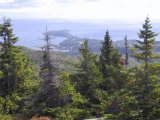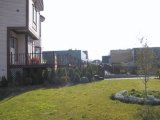
Cape Breton
We cross the flat Canso Causeway to Cape Breton Island and Highway 105 opens up… and up and up. It’s a pretty steep ascent from the water and Melanie makes the best of it, passing an ambulance along the way. Forty-five minutes later we stop in Baddeck, a neat little town on the edge of Big Bras D’Or lake. We stop for a good lunch at the Yellow Cello on Chebucto St.

 Baddeck was the retirement home of Alexander Graham Bell and on a hill outside of town is the Bell National Historic Site, an interesting (though not completely captivating) museum dedicated to the man behind the telephone and numerous other inventions and improvements. The giant hydrofoil exhibit is worth the price of admission.
Baddeck was the retirement home of Alexander Graham Bell and on a hill outside of town is the Bell National Historic Site, an interesting (though not completely captivating) museum dedicated to the man behind the telephone and numerous other inventions and improvements. The giant hydrofoil exhibit is worth the price of admission.
About a half hour outside Baddeck we hit Cape Smokey – a 750-foot climb in half a cliff-hugging mile of two-lane road. Kinda scary in the fog, blood draining from my feet like on Taylor Avenue in San Francisco, but suddenly we’re out on top (dangling over the Atlantic) and our destination is wheeling into view.
A few minutes later we pull into the Cape Breton Highlands Park station to get our two-day pass.

 The Keltic Lodge is perched on a narrow spit of rock that juts out into the Atlantic. Run by the same outfit that owns the Liscombe, it’s pricy and could stand a little updating in spots (furnishings in our cabin are vintage 1970) but the location makes it easy to forgive any shortcomings.
The Keltic Lodge is perched on a narrow spit of rock that juts out into the Atlantic. Run by the same outfit that owns the Liscombe, it’s pricy and could stand a little updating in spots (furnishings in our cabin are vintage 1970) but the location makes it easy to forgive any shortcomings.
Just book early for dinner. We get shut out until 8:45 the first night.
Melanie strikes off to explore the rest of the rocky point while I noodle on my travel guitar and call the office to find out more about the HP/Compaq deal (don’t worry -yet). Melanie returns within the half hour and heads back toward the lodge to take some photos. Restless and with an hour and a half to kill before dinner I head off to find the end of the spit.
The trail is rugged and narrow and slices through some thick overgrowth. In a clearing I spot a yellow fishing boat in the distance and race through the next little forest to find a closer spot to set up some photos. The little forest isn’t as little as I thought. When I finally emerge at the end of the trail the yellow boat is long gone, dusk is gathering and the ocean birds are coming home to the rocks for the night. I realize that I haven’t seen another human on the trail since I left the parking lot – everyone’s in for the evening. It’s desolate out here; I can see lights popping on across the coves miles away to either side, and I’m separated from the lodge by the thick woods. The water is a deadly couple of hundred feet below, and as the breeze picks up I back away from the edge. I turn around and for a few panicked moments I can’t find the trail in the fading light. When I do pick up the path I race back toward the mainland, feeling like a little kid as I approach each pitch black cut in the overgrowth. It’s not going to get any lighter if I wait. Dark + isolation + hundred-foot cliffs = wee bit of tension… which melts away at the first sight of streetlamps through the thick evergreens.
Melanie’s a little irked that I didn’t leave a note. That’s understandable.
The Purple Thistle restaurant is bustling and noisy but the food is surprisingly good, especially considering it’s part of the room rate.

 We begin the next day with a hike up nearby Mt. Franey – it’s windy and chilly, the uphill climb is brutal, but we’re rewarded with great views of the valley and the rocky spit we explored the day before.
We begin the next day with a hike up nearby Mt. Franey – it’s windy and chilly, the uphill climb is brutal, but we’re rewarded with great views of the valley and the rocky spit we explored the day before.
 We’re also rewarded with the world’s smallest blueberries.
We’re also rewarded with the world’s smallest blueberries.
 After the hike we head North to find the tip of the province. First we pause at the Coastal Waters Restaurant for a lunch of heart-stopping poutine, a fries-and-gravy concoction long the subject of expatriate Quebecois lamentations. Not bad… not good for you either, but we earned it after the morning hike.
After the hike we head North to find the tip of the province. First we pause at the Coastal Waters Restaurant for a lunch of heart-stopping poutine, a fries-and-gravy concoction long the subject of expatriate Quebecois lamentations. Not bad… not good for you either, but we earned it after the morning hike.

 Along the scenic route to the tip of Nova Scotia we stop at windswept White Point to check out the beleaguered fishing boats and the tenacious Canadian flag flapping over the little post office.
Along the scenic route to the tip of Nova Scotia we stop at windswept White Point to check out the beleaguered fishing boats and the tenacious Canadian flag flapping over the little post office.

 Clinging to a graded dirt road at the northernmost tip of Nova Scotia is Meat Cove, the end of the line. Legend has it the little town got its name from the passing ships that used the area’s caribou for nourishment before or after sailing the St. Lawrence river. Called the most isolated village in the province its fame has attracted enough visitors (including one painfully slow campervan) to blunt the end-of-the-world feeling we were looking for. Luckily I have those Keltic Lodge cliffs to look back on.
Clinging to a graded dirt road at the northernmost tip of Nova Scotia is Meat Cove, the end of the line. Legend has it the little town got its name from the passing ships that used the area’s caribou for nourishment before or after sailing the St. Lawrence river. Called the most isolated village in the province its fame has attracted enough visitors (including one painfully slow campervan) to blunt the end-of-the-world feeling we were looking for. Luckily I have those Keltic Lodge cliffs to look back on.

 The next morning we snap a few more pictures of the cape and the famous painted chairs at the lodge before heading back toward Halifax. A few bald eagles circle lazily in the clear sky. One teases us on our way out, daring us to stop and take a picture. We stop. He disappears.
The next morning we snap a few more pictures of the cape and the famous painted chairs at the lodge before heading back toward Halifax. A few bald eagles circle lazily in the clear sky. One teases us on our way out, daring us to stop and take a picture. We stop. He disappears.
 We decide to arc toward the West coast of Cape Breton, bypassing Meat Cove this time. We pause at the Aspy Fault to take pictures and try to make sense of the incomprehensible geological timeline posted by the side of the road.
We decide to arc toward the West coast of Cape Breton, bypassing Meat Cove this time. We pause at the Aspy Fault to take pictures and try to make sense of the incomprehensible geological timeline posted by the side of the road.
Before turning South we visit Gampo Abbey, the only Tibetan Buddhist monastery in North America. Daily tours are available when the abbey is not in retreat; sure enough the abbey is in retreat this week. I execute a respectful u-turn and wave to the workers furiously repainting the shrine. I guess retreat is the best time for the support staff to catch up on those little chores.
We haven’t seen any moose up to this point. We stop at Benjies Lake to search for wildlife; all we find at the lake is an older couple on a wooden bench. The woman hitches her pants back up as we approach. Not sure what led to her pants collapsing to the boardwalk.
Our next stop is Skyline, which promises spectacular views of the West coast. We walk for what feels like an hour along the boardwalk to the platform; approaching hikers greet our hellos with frozen grimaces and the occasional blunt bonjour. The view is worth the walk, and I think I can make out the little town of Cheticamp far below.
We stop in Cheticamp for a late lunch. Nothing in the town prepares us for what we find next.
The drive down Cape Breton and West across the province is uneventful, and as darkness sets we arrive in Truro, a tidy mid-size town about an hour from Halifax and maybe a half hour from the airport. There are a few rooms left in the John Stanfield Inn – the hotel is under major renovation, but the rooms have a certain charm. Besides, what are the chances of getting stuck next to an ice maker or elevator in a place this small?
 Shouldn’t have asked about the ice maker.
Shouldn’t have asked about the ice maker.

 At breakfast the next morning John the caretaker gives us a detailed rundown of the inn’s storied past (political and business intrigue of Nova Scotian proportions) and tells us everything he knows of desolate Newfoundland – how they only got milk in 1970 and for a long time the only greens were moldy bread.
At breakfast the next morning John the caretaker gives us a detailed rundown of the inn’s storied past (political and business intrigue of Nova Scotian proportions) and tells us everything he knows of desolate Newfoundland – how they only got milk in 1970 and for a long time the only greens were moldy bread.
We think about buying some frozen vegetables before our flight to St. John’s.
Halifax airport is pushing to modernize its system; an Air Canada representative shows us how to use the automated checkin kiosks. One swipe of a credit card and we’re ready to board our aging 737 for the short flight to Newfoundland.





